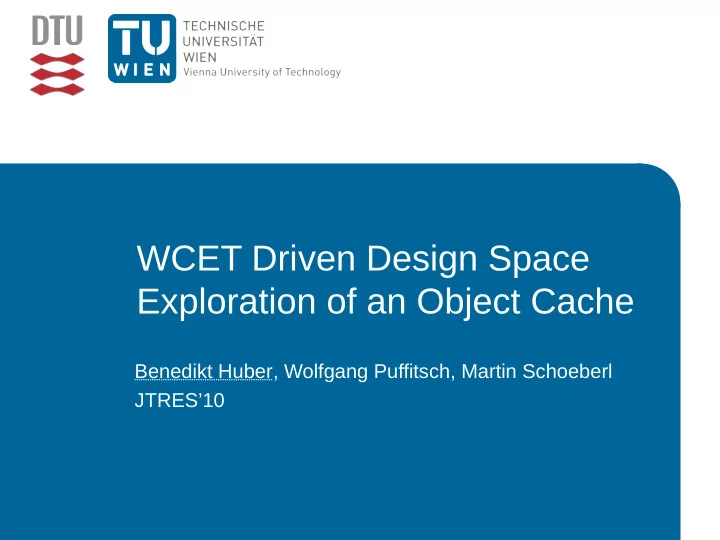

WCET Driven Design Space Exploration of an Object Cache Benedikt Huber, Wolfgang Puffitsch, Martin Schoeberl JTRES’10
Computer Architecture Design for Embedded Hard-RT Systems • Application Area • Resource-constrained hard real-time systems • Timing needs to be predictable! • Target Platform: Java Optimized Processor • Choosing the right components • Wide variety of performance-enhancing techniques • Example here: Data caches to bridge CPU/memory gap • Which choices are favorable for hard RT?
Cache Design for JOP Small processor for Safety-Critical Java Designed to allow precise worst-case execution time (WCET) estimations Non-trivial dynamic memory behavior • Garbage Collector • Objects shared between threads Data cache promises significant speedup (especially for multiprocessor version)
Conventional Cache Evaluation Create different implementations (Simulator/FPGA) Measure runtime on set of representative benchmarks Rank designs based on • Measurement results • Implementation cost Problem: No quantitative metric for timing predictability
Our Approach Use both simulation and static analysis results Based on static WCET analysis techniques • Program analysis (Dataflow analysis) • Worst-case calculation (ILP based) Avoid architecture designs without precise timing models • Waste of resources for hard RT systems • Usually more complex (error prone) static analysis ➔ WCET-guided architecture design
Split Cache Architecture • Distinguish data accesses based on address predictability and coherence issues i. Address known statically, immutable data ii. Same, but mutable data (cache coherence) iii. Heap allocated data (address statically unknown) • Split data cache for predictability! • Direct-mapped / set-associative cache for static data • No interference with unknown addresses → precise timing estimation possible • Object cache for heap allocated objects
The Object Cache • Fully-associative cache • Keeps track of 16-64 “active” objects • Handles (indirections not mutated by GC) as tag • Object Cache Entries • One (longer) cache line per object • Word Fill: one valid bit for each field • Burst Fill: fill cache line (or parts of it) at once
Data Cache Predictability • Is it possible to effectively limit the number of cache misses in a program fragment? • Addresses of heap-allocated objects? • Dynamic memory allocation • Garbage Collector (changes address) • Allocated in a different thread • Heap-allocated objects + Direct Mapped Cache • If the address of accessed datum is unknown, it might evict any other datum from a direct-mapped cache
Object Cache Predictability • First approximation: Number of possible conflicting accesses in program fragments • Object Cache with Associativity N (FIFO & LRU): No conflict if at most N distinct objects are accessed in a program fragment • Compare to set-associative cache • Assuming address of handle is unknown • Worst-case scenario: All objects map to the same cache line in set-associative cache
Object Cache: Static Analysis (1) Cache Hit/Miss Classification • Standard technique for instruction caches • Does not work (well) if addresses are unknown Local persistence analysis • Restrict number of cache misses in program fragment • Requires architecture with composable timing Integration into WCET calculation • We use Implicit Path Enumeration Technique (IPET) • Cache analysis adds inequalities restricting cache cost
Object Cache: Static Analysis (2) Persistence Analysis Implementation • Run on selected program fragments (bottom-up search) i. Dataflow Analysis Compute symbolic name of accessed objects (relative to scope entry) ii. Max-Cost Network Flow Analysis Compute maximal number K of distinct objects used in the scope iii. IPET Integration If K <= Associativity: IPET inequalities to restrict number of cache misses
WCET-driven Object Cache Evaluation • Uses our WCET Analysis framework • Compute cache miss cycles for set of embedded Java Benchmarks • Assume cold cache, no interference with other components • Different configurations • Different Associativity, Line Size • Burst mode (load full line at once) • SRAM and SDRAM (latency for first word)
Evaluation: Object Cache Configuration • Line Size • Object sizes vary depending on benchmark • 16 words sufficient for all benchmarks • Associativity • Few „active objects“ (2-8) relevant • Realistic ? Benchmarks are all we have • Burst Mode • Line fill (avoids valid bit) does not work well enough • Coincides with average case observation • Small benefits from 4-word burst (SDRAM)
Evaluation: Hitrate • Results close to measured average case performance • 43%-91% hit rate • For some benchmarks, not a lot of locality • Analysis also needs improvements • Revealed a few weaknesses in the analysis • Does not take positive effect of aliasing into account • Does not use known loop bounds when counting number of distinct objects
Conclusion • Designers need to take predictability into account • Need WCET to verify temporal behavior • Unpredictable architecture: gross overestimations → waste of resources • WCET Analysis techniques for quantitative estimate of „worst-case performance predictability“ • Implementation and analysis for the split cache architecture to be finished
Recommend
More recommend